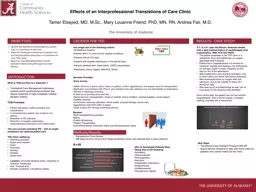

State the challenges and barriers to patient care and interdisciplinary education in a transitions of care TOC clinic Report 30 Day Rehospitalization and ED Utilization Rates Using Retrospective Chart Review ID: 908759
Download Presentation The PPT/PDF document "Identify the benefits to interdisciplina..." is the property of its rightful owner. Permission is granted to download and print the materials on this web site for personal, non-commercial use only, and to display it on your personal computer provided you do not modify the materials and that you retain all copyright notices contained in the materials. By downloading content from our website, you accept the terms of this agreement.
Slide1
Identify the benefits to interdisciplinary patient care in a transitions of care clinic.State the challenges and barriers to patient care and interdisciplinary education in a transitions of care (TOC) clinic. Report 30 -Day Rehospitalization and ED Utilization Rates Using Retrospective Chart Review.
What is TCM and Why Is it Important ? Transitional Care Management addresses medical and/or psychosocial problems that require moderate or high complexity medical decision making.TCM Promotes: Patient well-being, health promotion and maintenance. A comprehensive patient care model at one setting. Reduction of ED utilization.Reduction of hospital readmission.Interprofessional Education and Collaboration. The core concept animating IPE -- that no single profession can optimize patient care. TOC Clinic staffed by: Attending physician Upper level resident Intern Pharmacy Nursing Dietitian Social workLocation: University Medical center, University of Alabama Tuscaloosa. Day: Thursday A.M.Number of patients: 4-6 patients weekly.
Any single one of the following criteria:All Medicare PatientsPatients with 2 or more chronic medical conditions. Patients with an ICU stay. Patients with hospital readmission in the last 90 days.Patients admitted with: Heart failure, COPD exacerbation, Respiratory failure, Sepsis. AMI/ACS, Stroke.Services Provided:
Effects of an Interprofessional Transistions of Care Clinic
Tamer Elsayed, MD, M.Sc., Mary Louanne Friend, PhD, MN, RN, Andrea Fair, M.D.The University of Alabama
OBJECTIVES
INTRODUCTION
CRITERIA FOR TOC
RESULTS: CASE STUDY
.
Next Steps
Transitional Care Outreach Program with NP
Social Service Students to help with home visits for patients who cannot make it to the clinic.
S.Y. is a 61- year old African- American female with a past medical history of cardiomegaly (has a pacemaker), DMII, HTN and CKD3.
The patient presented to the TOC clinic in a wheelchair (from deconditioning), on oxygen, depressed and frustrated.
Patient had 5 hospitalizations in 6 months for anasarca, hypoxia and dyspnea. Her admissions, on average, lasted 10 days. Required an ICU stay for two of the admissions.
Was treated with Lasix and fluid restriction, only to return within the month with severe anasarca. Was discharged home on oxygen after one admission, due to her inability to wean off it during her stay. Was seen by GI and Nephrology as well, but no true cause for the anasarca was identified. Nine months later, the patient has not had another hospitalization. She is off her oxygen, is happily walking, and feels like a new person.
Early access:
Within
48 hours a phone call to check on patient, confirm appointment, and assess need for transportation.
Medication reconciliation with Phar.D. and residents who also address cost and affordability of medications. Review of discharge summary.Follow-up on pending tests and labs.Social services: transportation, meals on wheels, home condition, medical supplies, social support. Dietitian services.Community resources utilization: Home health, physical therapy, wound care.Appointment with PCP within 2 weeksOpen access 24/7 through answering service.Barriers:EHR Template/DocumentationBillingPatient SchedulingPatient TransportationCost-Effectiveness: Education Value and Reimbursement ValueRetrospective Chart Review IRB Approval from UA and DCH Regional Medical Center was obtained prior to data collection. N = 84
89% of
Discharged Patients Were
Taking One of the following:
Antibiotics
Glucocorticoids Anticoagulants NarcoticsAntiepileptic medications Antipsychotics AntidepressantsHypoglycemic agents
Methods/Results